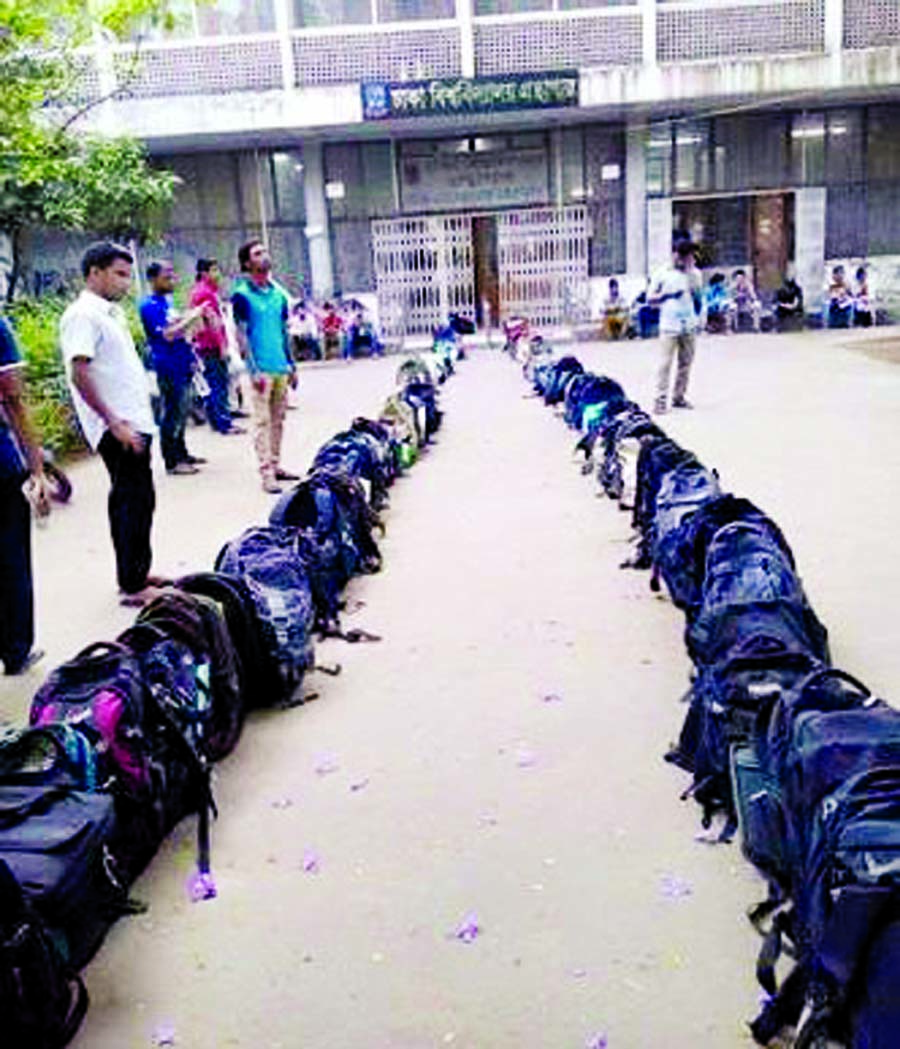
Rayhanul Islam :
Although the number of Dhaka University (DU) students has increased over the years, the accommodation in its central library has not been expanded accordingly. As a result, students are facing adequate library facilities.
If anyone pays a visit to DU early in the morning, he will find a weird line of bags in front of the central library’s entrance gate.
Bags stuffed with books lie on the road in front of the entrance gate of library and they act as a placeholder for students in row.
As the clock nears 8:00am, students stand close to their bags and get ready to grab a seat inside the library as soon as it opens. This is because of shortage of seats in the library, which can accommodate around 2,000 students at a time. So, they have discovered this unique way of getting into the library and finding a seat.
“We have to keep our bags in line by 6:30am to get a seat in the library, otherwise we won’t get it. Sometimes we stand in queue in front of the library gate, but standing for long is quite difficult,” said Mostafizur Rahman Nafiz, a Masters student of Islamic Studies Department.
Although the number of DU students has climbed over the years, the university authorities could not expand the library’s accommodation facility accordingly.
According to library officials, the Central Library and the Science Library can jointly accommodate for around regular 2000 students. This means one out of 20 students can access to get a seat.
Moreover, recently the authorities installed automated gate security system but it did not give good result lack of proper overseen. As a result, non- students and outsiders can also get into the library to take preparation for exams like BCS (Bangladesh Civil Services) examinations or for other jobs, deepening the space crisis and depriving the regular students.
“Former students and outsiders often keep seats occupied,” alleged Yasmin Jahan, a fourth-year student of Philosophy Department.
Adnan Habib Khan, a first year student of Islamic History and Culture Department, told The New Nation, “We have to struggle during exam times, as it is hard to get a seat at the central library. I along with my 30 friends live in the ‘gono room’ (common room of a dorm where freshmen are crammed into) at Hazi Muhammad Muhsin Hall where it is almost impossible to study.”
Although there are one or two reading rooms in every residential dormitory of DU, students prefer going to the central library due to the better atmosphere.
Tashin Ahmed who graduated recently from the university used to visit the library regularly. “I come here with some of my friends to prepare for job tests. We have breakfast and lunch on campus and keep our books on the seats so that others can know that those are occupied. We can study here soundly which is not possible in our mess at Azimpur.”
During a visit to the library it was seen that most of people there were studying books on job exams they had brought with them. Besides, such guidebooks were kept on the vacant seats so that others could not use them.
Contacted, librarian Professor SM Zabed Ahmed said that 2000 seats are not inadequate rather it is enough for a library. We have more seats from the library of developed countries’ universities.
“The central library building is a heritage and it cannot be expanded vertically,” he said, adding that we gave preamble for constructing a new multi-storied building for library.
About the access of irregular and former students, he said, “Some DU students come here with their friends of other institutions. Some bring fake IDs. We introduced digital ID cards, but it needs one or two years time that all students will get the ID cards.”
DU Vice-Chancellor Professor Akhtaruzzaman said that we have huge number of students but the university faces infrastructural problem. So, we have planned to build a multi-storied building for solving the seat crisis of the library.
The central library that began its journey simultaneously with the Dhaka University in 1921 has 674,538 books and magazines. Besides, it has 30,000 rare manuscripts and a large number of booklets, leaflets, pamphlets, and puthis, which are preserved in microfilms along with some rare books and documents.

